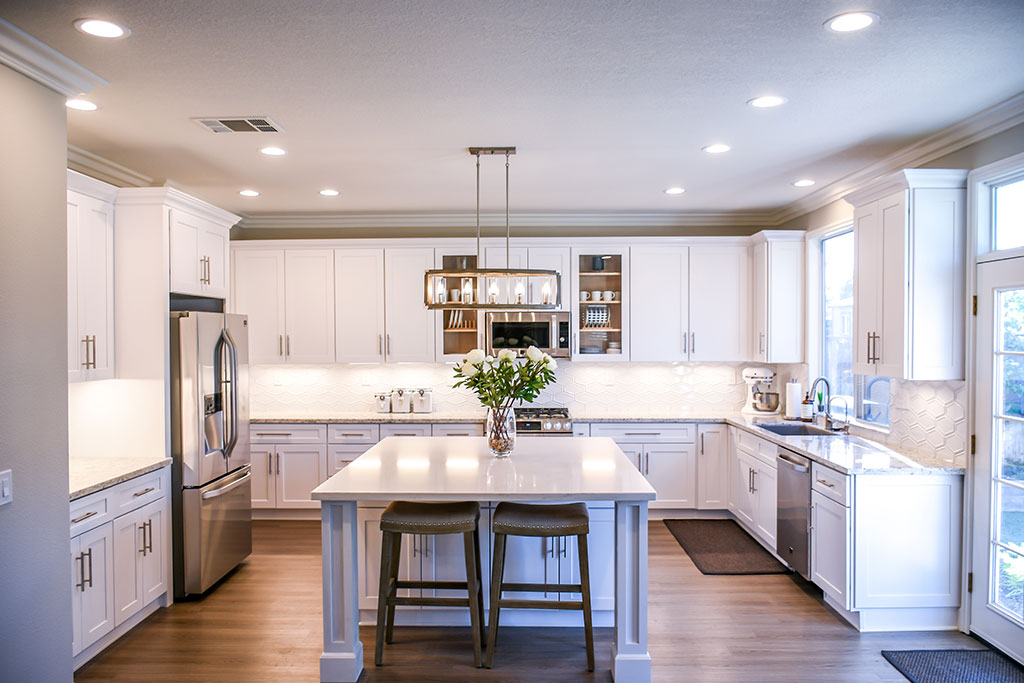5 Best Kitchen Cabinet Materials: Pros and Cons

In today’s world, there are so many kitchen cabinet materials on the market. How can you decide which one is right for your home?
If you’re looking for style and longevity, solid hardwood might be best. If you’re seeking a fun, bright color that stands up to high traffic, medium density fiberwood (MDF) could be ideal. Here are all the kitchen cabinet materials pros and cons you need to know to make the best choice for your kitchen renovation.
Pros and Cons of 5 of the Most Popular Kitchen Cabinet Materials
When you’re giving your kitchen a makeover, you’ll want to carefully select your cabinet material. Always keep in mind your kitchen design, color scheme, and remodel budget.
To help you make your decision, here are the pros and cons of five leading kitchen cabinet materials.
1. Solid Hardwood Cabinets
Hardwood cabinets are extremely popular. They come in a variety of styles and can have natural, stained, or painted finishes.
Pros:
- High-quality hardwood cabinets are always in style and will add timeless beauty to your home.
- Wood comes in a wide range of colors offered by varying natural wood species, including cherry, oak, birch, walnut, hickory, and more.
- Scratches are usually easy to cover or buff away, and that’s if they get scratched in the first place. Wood cabinets are usually strong and resistant to damage.
Cons:
- Wood cabinets tend to be more expensive than other cabinet materials.
- Solid wood reacts naturally to humidity, which could result in warping or cracking over time.
- Hardwood cabinets can be high maintenance – they can only be cleaned with non-abrasive products.
2. Melamine Cabinets
Melamine is a popular plastic material used to make many kitchen cabinets. It’s durable and has a wide range of color patterns available. Plus, when melamine is fused with plywood it’s one of the most sustainable materials for cabinetry.
Pros:
- Melamine releases nitrogen when it’s burned, making it fire retardant.
- The material melamine is moisture resistant so it doesn’t shrink or expand like natural wood.
- Melamine is highly durable, similar to wood, but it’s more cost-effective.
Cons:
- Melamine is a type 7 plastic, which means it cannot be recycled in traditional methods. It has to be ground down and used with other plastics.
- Since it’s heavier than other materials, melamine requires heavy-duty hinges and glides.
- Melamine is susceptible to splintering.
3. Wood Veneer Cabinets
Wood veneers are one of the more innovative materials for kitchen cabinets. Manufacturers take a thin piece of wood and adhere it to a produced base material. The result is a strong cabinet with the look and feel of real wood.
Pros:
- Veneer cabinets look and feel like natural wood, but are cheaper.
- Nicks and abrasions can be easily buffed to restore appearance.
- Wood veneer is reasonably durable (more than laminate, but less than solid wood) so it’s highly resistant to warping.
Cons:
- Prolonged exposure to moisture can loosen the veneer from its base, causing a “bubbled” effect.
- Veneer can be costly to repair since the entire surface usually needs to be replaced once damage occurs.
4. Medium-Density Fiberboard (MDF) Cabinets
Medium-density fiberboard, most often known by its initials, MDF, is an engineered wood product made by breaking down hardwood or softwood residuals into wood fibers, combining it with wax and a resin binder, and forming it into panels by applying high temperature and pressure.
Pros:
- Since MDF is composed of small particles of wood fibers mixed with wax and resins, the result is a smooth, even wood grain.
- Cabinets made of MDF are easy to paint. You can switch out the color whenever you want to go for a new look in the room.
- MDF is manufactured in large pieces (unlike wood, which is limited to the size of the tree it’s cut from), making it easy to craft into a variety of kitchen cabinet styles.
Cons:
- Since MDF can’t be sanded, chips and scrapes are not repairable.
- The material of MDF will not stand up to high temperatures.
- If you put too much weight on MDF boards, sagging can occur.
5. High-Pressure Laminate Cabinets
High-pressure laminate (HPL) is constructed of multiple layers of kraft paper saturated with resins, topped with decor paper, and fused by heat and pressure. This forms a single, rigid laminated sheet.
Pros:
- Though HPL is similar to melamine, it’s manufactured of multiple layers, making it more scratch-resistant.
- HPL cabinets come in a wide range of colors and finishes.
- HPL material does not require staining or finishing, making it easy to clean.
Cons:
- Although it’s still cost-effective compared to many other materials, high-pressure laminate is pricier than melamine.
- HPL materials have a low resistance to bacteria, chemicals, and corrosion.
- Because the laminate is pressed together, it may start to lift over time.
Shop For Cabinets With Standard Supply & Lumber
Now that you know all the kitchen cabinet materials’ pros and cons, you can pick the perfect cabinetry for you. No matter which cabinet material you choose, Standard Supply & Lumber is here to help.
We’re proud to offer selections from top-name brands like Merillat and Ultracraft. Our Elevations Design Studio by Zeeland Standard experts are here to help you select the perfect finish and color, no matter what your style or budget is. Give us a call or contact us online for more information.
